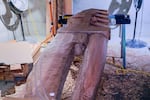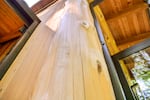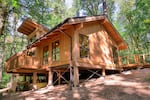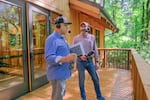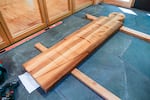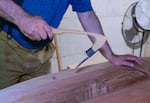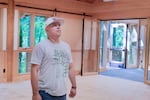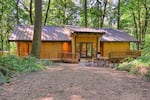
The nonprofit Friends of Tryon Creek is opening on Sep. 20, 2025 a new education pavilion to provide year-round programming, including field trips, day camps and community events at the Tryon Creek State Natural Area in Southwest Portland. This photo taken on Sep. 13, 2025 shows the front of the roughly 2,900-square-foot pavilion which is designed to resemble plankhouses used by Northwest Indigenous tribes for potlatches, ceremonies and other events.
Sheraz Sadiq / OPB
This Saturday, a new education pavilion is opening at Tryon Creek State Natural Area. The roughly 660-acre day-use area located in Southwest Portland near Lake Oswego is the only Oregon state park within a major metropolitan area.
The Friends of Tryon Creek raised the funds for and oversaw the construction of the new facility that will allow the nonprofit to provide year-round community events and educational programming for thousands of students who come each year to experience day camps, field trips and classes at Tryon Creek.
News of the pavilion’s opening was first reported by Oregon ArtsWatch.
“School groups that are coming from East Portland, from Beaverton, Hillsboro, Canby, Wilsonville, they generally, you know, want a place to have lunch, a place where students can sit down and rest a little bit,” said Friends of Tryon Creek executive director Gabe Sheoships, who is Cayuse and Walla Walla and a citizen of the Confederated Tribes of the Umatilla Indian Reservation.
Tryon Creek’s new center will also remind students and visitors of the enduring cultural legacies of Northwest Indigenous tribes and their stewardship of the environment extending beyond the Douglas fir, big leaf maple, red alder and western red cedar that dominate this urban forest canopy.
Input from community members helped inform the pavilion’s design which was based on plankhouses used by tribes as community spaces to gather for potlatches, ceremonies and other functions.
“We really heard from tribes, tribal partners, and had this opportunity to represent kind of the Indigenous architecture of the space, so a plankhouse with cedar planks, having mature western red cedar logs as kind of the backbone of the structure.
“But a little different in that we have a lot of windows that are floor to ceiling, … so we’re holding on to the views and … it definitely feels like you’re still in the forest.”

Friends of Tryon Creek executive director Gabe Sheoships poses for a portrait on Sept. 13, 2025, at the new education pavilion which was designed to evoke traditional plankhouses used by Indigenous Northwest tribes for potlatches, ceremonies and other events.
Sheraz Sadiq / OPB
The new pavilion has two classrooms with air conditioning, whiteboards, chalkboards, modern A/V equipment, custom-made barn doors and floor-to-ceiling glass walls that open onto a hallway made of bluestone, a blue-gray composite stone chosen to represent Columbia River flood basalts that helped shape the geology of the Northwest.
A covered fire pit lies in the middle for use during special occasions in the nearly 2,900-square-foot pavilion, which replaces a wooden gazebo built in 1975 that was open on all sides.
Douglas fir boards that could be salvaged from the old gazebo were reused for the new construction, tying the new space with reminders of the generations of students who’ve been lucky enough to have this temperate rainforest as a classroom.
“We’re building in a living, intact ecosystem and we’re not conquering it,” Sheoships said. “We made a very strategic effort to build within the forest and the wooden materials will represent the living forest that will obviously grow up around us,” he added.
Roughly half of the pavilion’s $2.6 million cost has come from donations made by individuals and family foundations. The project has also received grant funding from philanthropic organizations and public agencies such as Oregon State Parks and the Metro regional government, which awarded it $350,000 in 2023.
Two years earlier, the Oregon state legislature allocated $250,000 in federal pass-through funding from the American Recovery and Reinvestment Act to kickstart the project. Sheoships says roughly $300,000 remains to be raised, which Friends of Tryon Creek aims to do by year’s end.
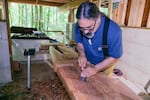
Artist Shirod Younker uses a chisel to work an 8-foot-tall carving he’s making out of western red cedar on Sep. 16, 2025 inside the basement of the new education pavilion opening at the Tryon Creek State Natural Area in Southwest Portland. Younker is Coos, Miluk and Umpqua, a citizen of the Coquille Indian Tribe and one of four Northwest Indigenous artists commissioned to create artwork inside the new space.
Sheraz Sadiq / OPB
The nonprofit commissioned four Indigenous artists from different Northwest tribal nations to make original works that will be permanently displayed inside the pavilion.
In a makeshift studio set up for him in the pavilion’s basement, Shirod Younker is completing an 8-foot-tall sculpture carved out of western red cedar inspired by house posts found in traditional plankhouses.
“A house post is something that holds up, like the ridge pole that holds up the roof or holds up other beams that you can set the sides on,” said Younker. “There’s usually two main ones that are on the opposite ends of the building and sometimes those would be carved.”
Younker is Coos, Miluk and Umpqua and a citizen of the Coquille Indian Tribe, whose ancestral lands span the southern Oregon Coast.
In a nod to that heritage, Younker’s piece will be installed on the southern side of the pavilion directly facing an 8-foot-tall sculpture carved by Greg Robinson, an artist and citizen of the Chinook Indian Nation.
“So the idea is that there’ll be a conversation between the two pieces and kind of a nice metaphor for what the building hopefully will be, where people from different backgrounds and ethnicities can come in and exchange ideas, but make and learn all together as a collaborative,” Younker said.
Younker’s carving will feature an obsidian blade to signify status and wealth and also dentalium, a white shell that Indigenous tribes throughout the Pacific Northwest used for decoration and as a form of currency for trading.
Even though there may be no exchange of goods within the walls of the new space, the hope is that there will be an exchange of ideas inspired by the setting of Tryon Creek, its connection to the natural world and the lessons it beckons about the responsibility to protect it for future generations.

This photo taken on Sep. 13, 2025, shows the hallway inside the pavilion which separates two classrooms and is made of bluestone chosen to represent Columbia River basalt. A covered fire pit lies in the middle of the hallway.
Sheraz Sadiq / OPB
“I hope that young people will come here and will be able to express what we want them to know about this environment so that they’ll begin to love it, right? And that being said, when they love it, then they’ll want to protect it or take care of it,” Younker said.
“This building will give a space for gathering, a space for communion, a space for playing, a space for making friends, a space of connection that would then be a gateway to this larger forest and many others throughout the region and really the world,” Sheoships said.
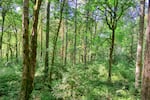
Tryon Creek State Natural Area in Southwest Portland is a temperate rainforest with moss-covered Douglas fir, western red cedar, big leaf maple and red alder trees dominating its urban forest canopy. This photo taken on Sep. 16, 2025 at Tryon Creek State Natural Area shows a view of stands of Douglas fir trees and ferns growing on the forest floor.
Sheraz Sadiq / OPB
The public is invited to attend an opening celebration at Tryon Creek State Natural Area from 2-4 p.m. this Saturday featuring a salmon bake, tours of the new pavilion and a welcoming ceremony.
Gabe Sheoships and Shirod Younker spoke to “Think Out Loud” host Dave Miller. Click play to listen to the full conversation:


